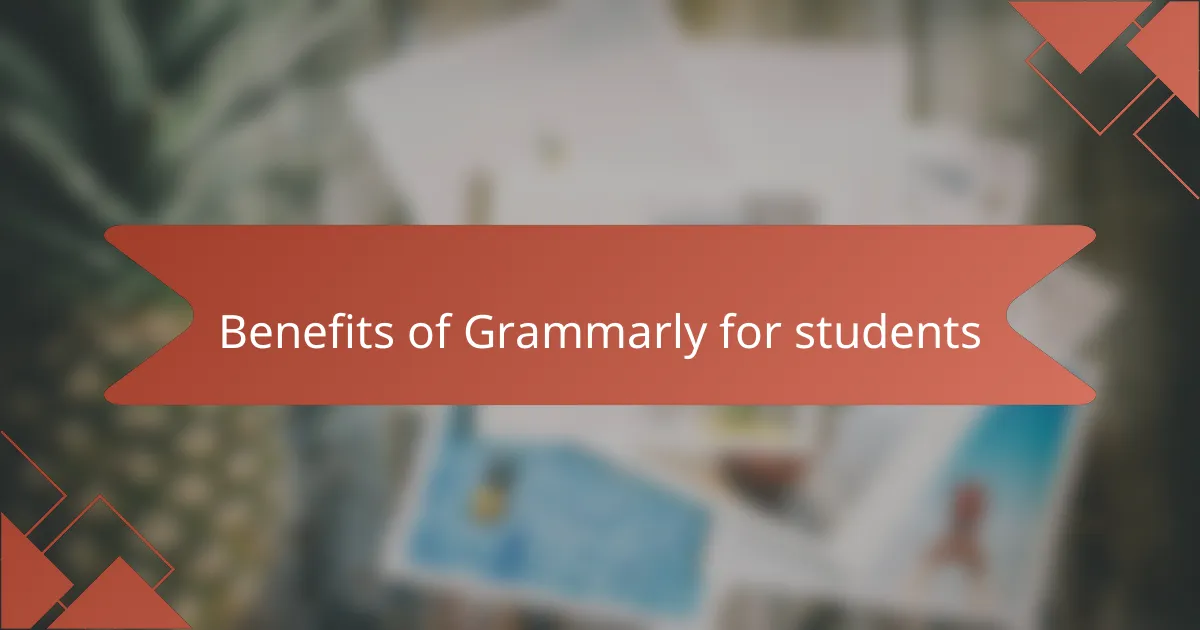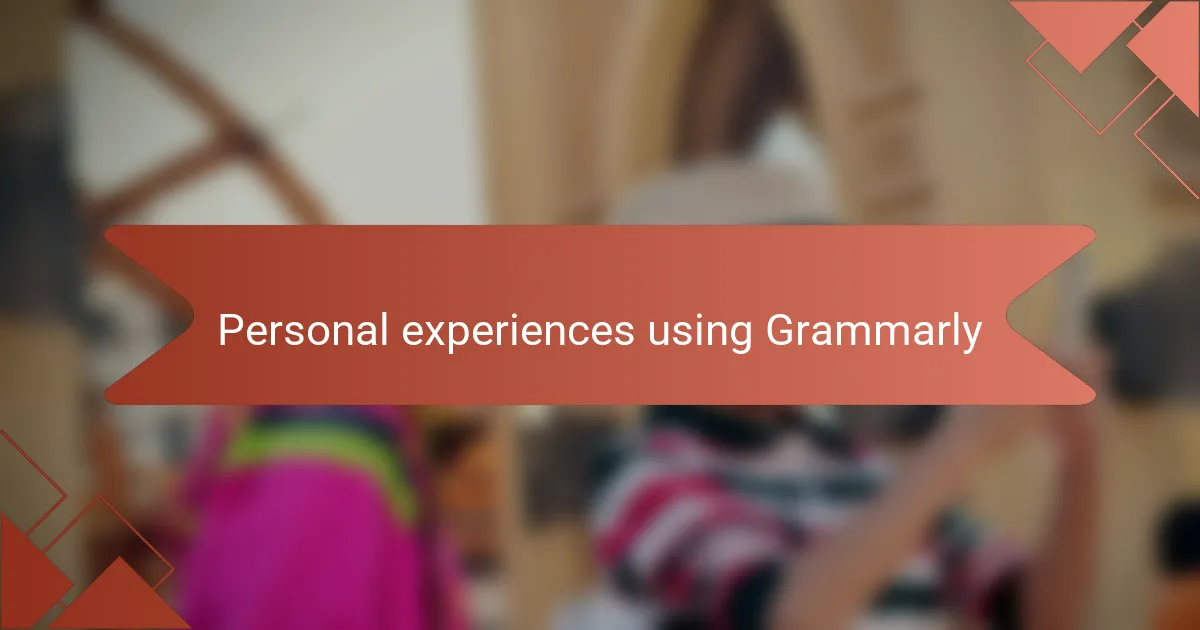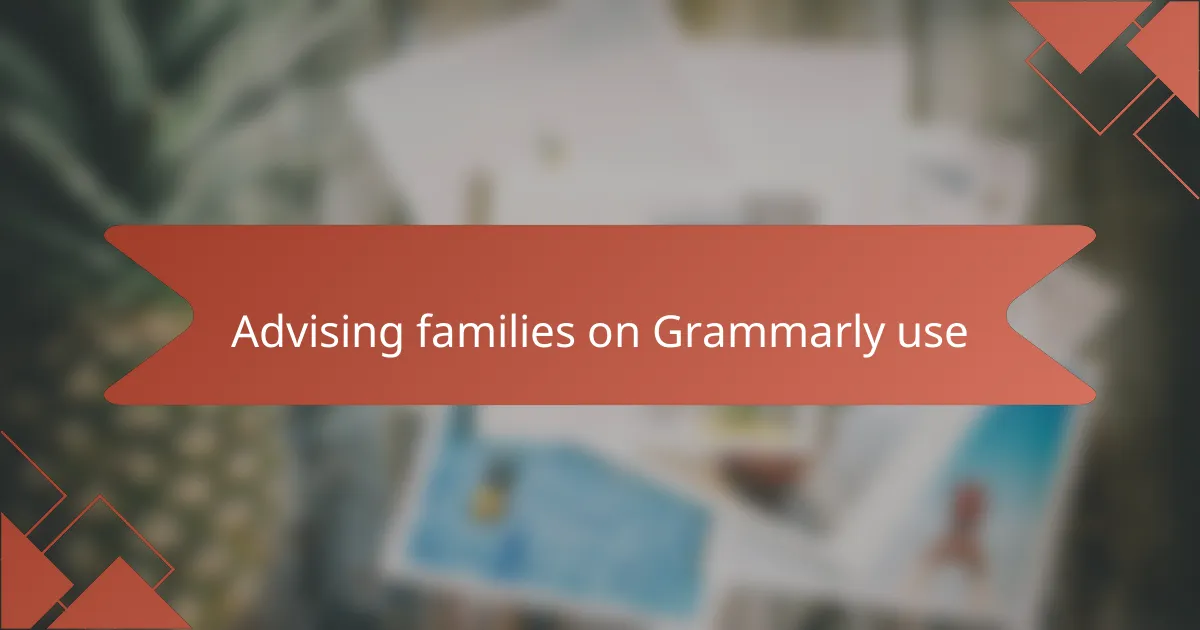Key takeaways
- Grammarly functions as a personal writing assistant, providing grammar, tone detection, and vocabulary enhancement to improve writing quality.
- It helps students learn by explaining errors, fostering independence in editing, and boosting their confidence in writing.
- Encouraging thoughtful review of Grammarly’s suggestions allows students to maintain their authentic voice while learning from the tool.
- Combining Grammarly with family discussions enhances understanding and reinforces writing skills, creating collaborative learning environments.

Understanding Grammarly and its features
Grammarly is more than just a spell checker; it’s like having a personal editor at your fingertips. From catching grammar mistakes to suggesting clearer phrasing, it digs deeper into the text than many expect. Have you ever paused mid-sentence, unsure if your wording sounds right? That’s where Grammarly often becomes surprisingly helpful.
One feature I find particularly valuable is its tone detector. It gives an idea of how your writing might come across to others—whether it’s formal, friendly, or somewhere in between. When helping my kids with their homework, this insight prompts thoughtful adjustments that make their work feel more authentic and engaging.
Beyond grammar and tone, Grammarly also offers vocabulary enhancement suggestions, encouraging richer word choices. It feels like a mini writing coach guiding you to express ideas better without overwhelming you. In my experience, this makes the process of finishing homework less stressful and more confidence-building.

How Grammarly supports homework tasks
What I’ve noticed is that Grammarly turns homework from a chore into a learning moment. Rather than just fixing mistakes, it explains why something might be wrong, which helps my kids actually understand their errors. Have you ever seen a child’s face light up when they suddenly “get” a tricky grammar rule? That’s the kind of little victory Grammarly often sparks at our kitchen table.
Sometimes, I wonder if relying on technology might make kids lazy writers. But I’ve found the opposite with Grammarly. It encourages them to think twice about word choices and sentence flow, almost like having a patient tutor nearby. When my daughter uses it, she’s more willing to revise and improve her work, which feels like a win for both of us.
Plus, the quick feedback means homework doesn’t drag on late into the night. I’ve seen how catching errors early saves time and frustration, allowing us to finish assignments with a bit of breathing room. Isn’t that a relief for any family juggling multiple schedules? For me, Grammarly feels like a subtle but steady helper in those busy homework sessions.

Benefits of Grammarly for students
One of the biggest benefits I’ve seen with Grammarly is how it boosts students’ confidence in their writing. When my son started using it, he wasn’t just correcting mistakes—he was actually proud to turn in cleaner, clearer essays. Have you noticed how a little confidence can transform a reluctant writer into someone eager to tackle the next assignment?
Another thing I appreciate is how Grammarly supports independent learning. Instead of me hovering and pointing out every error, my daughter uses the tool to catch slip-ups on her own. This independence is huge for developing responsibility, don’t you think? It’s like giving them a safety net that gently nudges them in the right direction without taking over.
Lastly, Grammarly’s suggestions often spark real “aha” moments. I remember my kids puzzling over how to rephrase clunky sentences or avoid repetitive words, and Grammarly’s vocabulary tips opened up new possibilities for expression. It’s rewarding to see them grow not just as students, but as creative communicators who care about the quality of their work.

Personal experiences using Grammarly
When I first introduced Grammarly to my family, I was a bit skeptical about whether it would really make a difference. But then I watched my youngest pause thoughtfully after a suggestion, saying, “Oh, that’s why this sentence sounded off!” Moments like that made me realize Grammarly isn’t just fixing errors—it’s building understanding. Have you ever seen a tool quietly boost a child’s confidence like that?
One afternoon, while helping with a particularly tricky essay, I noticed Grammarly catching subtle tone issues that I missed. It nudged my son to soften a phrase that sounded too harsh for his intended audience. That little change sparked a discussion about how word choice affects readers, something I hadn’t expected from software. Isn’t it amazing when technology becomes a conversation starter in your home?
I also love how Grammarly makes the revision process less frustrating for both me and my kids. Instead of endless back-and-forth corrections, it offers instant feedback that keeps momentum going. I remember one evening when homework wrapped up with time to spare—something rare in our busy household. It made me wonder, why didn’t we try this sooner?

Tips for effective Grammarly use
For Grammarly to truly shine, I’ve found it’s best to encourage your kids to review each suggestion carefully instead of accepting everything blindly. After all, not every correction fits the meaning they want to express, so taking a moment to think it through keeps their authentic voice intact. Have you noticed how this little pause helps turn automatic fixes into genuine learning moments?
Another tip I swear by is customizing Grammarly’s settings to match the assignment type. For instance, switching to a formal tone for essays or a casual one for creative projects makes the feedback feel more relevant and helpful. When my daughter adjusts these preferences, the suggestions seem smarter and less intrusive—a small step that really improves the experience.
Finally, don’t hesitate to pair Grammarly with a quick human check-in, especially when tackling big papers. Sometimes, a conversation about why a suggestion matters deepens understanding more than any automated note can. I remember one night when my son and I debated a word choice Grammarly flagged, and that discussion turned into a priceless teaching moment I wouldn’t trade for perfect grammar alone.

Balancing Grammarly with personal learning
Striking the right balance between using Grammarly and encouraging personal learning has been something I think about often. I’ve noticed that when my kids actively review each of Grammarly’s suggestions instead of just clicking “accept,” they engage more deeply with their writing. Isn’t it fascinating how a little mindful pause can turn a quick fix into a meaningful lesson?
There are times when I purposely step back to let my children wrestle with tricky sentences on their own before turning to Grammarly. Watching them struggle and then light up when they figure out a solution themselves reminds me that personal learning still holds immense value. I believe Grammarly is a fantastic guide, but personal effort fuels real growth.
At the same time, I’m careful not to let Grammarly become a crutch. I encourage my kids to try drafting without it first, then use Grammarly as a second pair of eyes. This way, their original voice and ideas stay front and center, while the tool helps polish rather than replace their work. Have you ever seen a child beam with pride after realizing they can produce strong writing even before any software steps in? That moment, to me, is priceless.

Advising families on Grammarly use
When advising families about Grammarly, I often suggest treating it as a helpful guide rather than a total fix. Have you noticed how kids sometimes rush to accept every suggestion? Encouraging them to pause and think about each change really deepens their understanding and keeps their unique voice alive. In my experience, this approach turns a simple tool into a real learning partner.
Another point I always emphasize is the importance of tailoring Grammarly to fit your family’s needs. For example, adjusting the tone settings to suit different assignments makes the feedback feel more relevant. I remember when my daughter switched to “formal” mode for a school essay—it made the corrections clearer and less frustrating, which was a huge relief for both of us.
Finally, I believe that Grammarly works best when combined with some family discussion. After all, a quick chat about why a suggestion matters can make all the difference. One evening, my son and I debated a vocabulary tip Grammarly offered, and that little conversation sparked a new understanding of how word choice shapes meaning. Isn’t it wonderful when technology invites connection rather than replaces it?